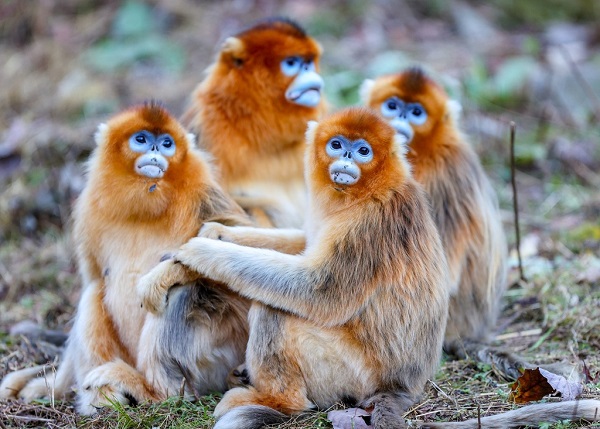Blog Post 5
One distinct feature of the Bornean Orangutan is their “long call.” The long call is a sound produced by flanged adult male orangutans. The call sounds similar to a roar and can sometimes be heard up to a mile away. The long call has been observed to serve two main purposes for orangutans. The first is to warn off any adversarial males from one's territory, and the other purpose is to announce a male's availability to any nearby sexually receptive females. (Orangutan Foundation International).\
Adult male Bornean orangutan long call This link takes you to a video of an orangutan performing the long call. This call was recorded by the researcher, Dr. Wendy Erb, who conducted the study being discussed in this post.
In a 2024 article (Erb et al.), researchers are analyzing the complexity of the long call. The article identifies that previous studies have found six distinct call types among orangutans. These sound types vary within individual orangutans and from orangutan to orangutan. None of the other studies on the orangutan long call have quantified the calls on discreteness or the ability of humans to reliably classify the calls. (Erb et al.). The low number of call types suggested that the long call was fairly simple, but the gradation boosts the complexity of the calls. This study was designed in response to a desire for more data on quantified gradedness in animal communication. The previous study done by Spillman identified six different pulse types, but the chart in the Erb study listed eight. The types are: grumbles, bubbles, roar, low roar, volcano roar, huitus, intermediary, and sigh. (Spillman et al.) This study also wanted to evaluate the complexity of the orangutan's long call based on diversity and distinguishability.
The two main factors being observed in this study are the number (diversity) of all call types and the discreteness (distinguishability) of each call type.The two methods used to observe the calls are manual visual/ audio-visual observations using a spectrogram observed and recorded by a human. A spectrogram is a device that creates a visual representation of sound.
---. “Vocal Complexity in the Long Calls of Bornean Orangutans.” PeerJ 12 (2024): e17320. Web. <https://doi.org/10.7717/peerj.17320>.
The image above is a spectrogram reading from the study. The other method used to measure the calls is automated measuring of the spectrogram readings. The point of having these two methods of observation is to compare the performance of humans versus the machines in differentiating unique call/pulse types. This study was able to capture 46 acoustic measurements from 1,033 pulses observed in 117 different long calls produced by 13 different males.
The human observers were able to discriminate well between huitus and sigh call types, but were only able to moderately discern between all six types. The machines performed better than humans at discerning some call types, they were less reliable at differentiating huitus, volcano, and intermediary pulses. The machines had an overall accuracy of 71%. The machines were best at discriminating sigh pulses. The lack of classification accuracy suggests that the six identified pulse types are not highly discrete.
The study concluded that orangutan long calls could be classified by humans and machines into three pulse types. The study recommended using already common terms in orangutan study to classify these three pulse types. The terms suggested are: roar for high-frequency pulses, sigh for low-frequency pulses, and intermediate for pulses that fall between the two extremes.
Due to the low number of suggested different call types, this study suggests that the orangutan's long call is not complex, but is instead intended to be heard in dense and noisy habitats across a great range. The study did acknowledge that the variance in intermediate calls indicates a complexity to the calls that was not able to be measured.
This research is the leading research on orangutan long calls at the moment. Most searches to find more information on the long call lead to this study or to articles that directly reference this study. This study was able to expand on existing knowledge of the long call and provide more quantified data on the different pulses within the call. I think that this study provides good insight into call complexity, and the use of machine identifiers helped negate some human biases. It is still possible that the orangutans themselves are able to detect more discerning call features and complexity that humans and machines are not.
Citations:
“Orangutan Foundation International – 97% of Our DNA...100% of Our Commitment! Supporting Conservation and Understanding of Orangutans.Orangutan Foundation International | 97% of Our DNA…100% of Our Commitment! Supporting Conservation and Understanding of Orangutans.” N.p., n.d. Web. <https://orangutan.org/orangutan-facts/orangutan-behavior/>.
Erb, Wendy M. et al. “Vocal Complexity in the Long Calls of Bornean Orangutans.” PeerJ 12 (2024): e17320. Web. <https://peerj.com/articles/17320/>.
Spillmann B, Dunkel LP, van Noordwijk MA, Amda RNA, Lameira AR, Wich SA, van Schaik CP. 2010. Acoustic properties of long calls given by flanged male orang-utans (Pongo pygmaeus wurmbii) reflect both individual identity and context. Ethology 116(5):385-395



Comments
Post a Comment